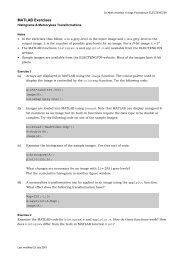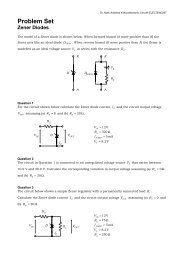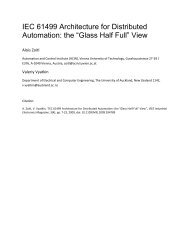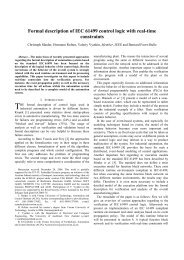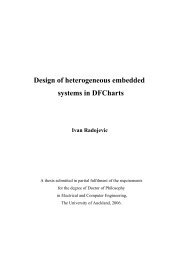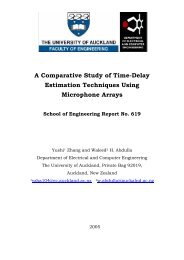5.2 Elastic Strain Energy
5.2 Elastic Strain Energy
5.2 Elastic Strain Energy
You also want an ePaper? Increase the reach of your titles
YUMPU automatically turns print PDFs into web optimized ePapers that Google loves.
U<br />
=<br />
L<br />
∫<br />
0<br />
2<br />
M<br />
dx<br />
2EI<br />
Section <strong>5.2</strong><br />
Solid Mechanics Part I 183<br />
Kelly<br />
(<strong>5.2</strong>.7)<br />
This expression is due to the flexural stress σ x . A beam can also store energy due to<br />
shear stress τ ; this latter energy is usually much less than that due to the flexural stresses<br />
provided the beam is slender – this is discussed further below.<br />
Example<br />
Consider the bar with varying circular cross-section shown in Fig. <strong>5.2</strong>.6. The Young’s<br />
modulus is GPa<br />
200 .<br />
Figure <strong>5.2</strong>.6: a loaded bar<br />
The strain energy stored in the bar when a force of 2 kN is applied at the free end is<br />
3 2<br />
( 2×<br />
10 ) ( 2)<br />
⎛<br />
⎜ 1 1<br />
+<br />
11<br />
2<br />
2(<br />
2×<br />
10 ) ⎜ −2<br />
−2<br />
( 5×<br />
10 ) ( 3×<br />
10 )<br />
L 2<br />
P<br />
U = ∫ dx =<br />
2EA<br />
0<br />
π ⎝<br />
⎞<br />
⎟<br />
−3<br />
= 9.<br />
62×<br />
10 Nm (<strong>5.2</strong>.8)<br />
2 ⎟<br />
⎠<br />
■<br />
<strong>5.2</strong>.2 The Work-<strong>Energy</strong> Principle<br />
The work-energy principle for elastic materials, that is, the fact that the work done by<br />
external forces is stored as elastic energy, can be used directly to solve some simple<br />
problems. To be precise, it can be used to solve problems involving a single force and for<br />
solving for the displacement in the direction of that force. By force and displacement<br />
here it is meant generalised force and generalised displacement, that is a<br />
force/displacement pair, a torque/angle of twist pair or a moment/bending angle pair.<br />
More complex problems need to be solved using more sophisticated energy methods,<br />
such as Castiglianos’ method discussed further below.<br />
Example<br />
2m<br />
r = 5cm<br />
Consider the beam of length L shown in Fig. <strong>5.2</strong>.7, pinned at one end (A) and simply<br />
supported at the other (C). A moment M 0 acts at B, a distance L 1 from the left-hand end.<br />
The cross-section is rectangular with depth b and height h. The work-energy principle<br />
can be used to calculate the angle θ B through which the moment at B rotates.<br />
2m<br />
r<br />
= 3cm<br />
2kN




